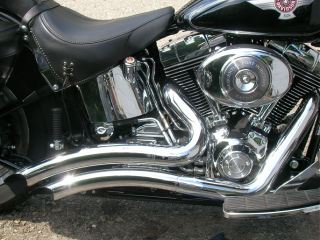Loud Motorcycles
Prohibited Exhaust Systems
The following section contains photo examples of loud aftermarket exhaust systems, and definitions that are designed to allow police (as well as the vehicle owners) to easily identify them. None of these examples of exhaust systems and mufflers meet EPA noise emissions standards.
Aftermarket Muffler
An aftermarket exhaust system that replaces the factory installed muffler.

Harley-Davidson Screamin' Eagle brand aftermarket exhaust system for a Harley-Davidson FLT.
Straight-Pipe Exhaust Systems
A motorcycle exhaust system that has the outward appearance of a uniform, consistent diameter the entire length of the system.
Straight-pipe exhaust systems are after-market exhaust systems that no motorcycle manufacturer ever installed on a production motorcycle directly from the factory. These systems are all designed simply to make noise, and possess sound levels far in excess (10-20dba) of current EPA manufacturing requirements. This is perceived to the human ear as three to five times louder.
It is impossible for any straight-pipe exhaust system to even come close to being an effective muffler. These exhaust systems do not have any expansion chamber to disperse the sound wave and slow down the exhaust gasses, nor do they incorporate any sound dampening material or reverse flow passages and chambers as have original equipment motorcycle mufflers for the past fourty years. They rely on exhaust restriction principals (when baffles are installed) to reduce noise emissions.


Baffles
A removable aftermarket motorcycle exhaust system component that is designed to reduce exhaust noise.
Baffles are typically small and very ineffective devices that when installed in straight pipe exhaust systems and some hollow-core mufflers, make these exhaust systems legal under most states laws. Below are examples of the most common types.




Hollow-Core Muffler
A muffler where the exhaust inlet is visible from the exhaust outlet.
Open-center or hollow-core mufflers are absorption type mufflers., They utilize an expansion area and usually sound-dampening material, but have an unobstructed internal passage straight through from the muffle inlet to the outlet with very little obstruction. As one might suspect, a muffler that one can see straight through cannot be very effective. These exhaust systems can easily be identified by a simple inspection by police and inspection mechanics.
|
|

